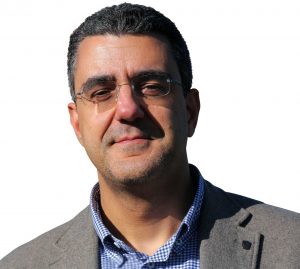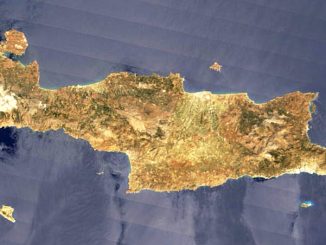The head of Medical Oncology at Ioannina University Hospital not only oversees ESMO’s prolific output of clinical guidelines, but also helps ensure that they can be sustainably delivered in his own country, where hospital budgets have never been so tight or doctors so few. Peter McIntyre asked him how he does it.
Since the start of the financial crisis in Greece, about 15,000 doctors have left to work in Germany, Sweden, the UK, France or the Middle East. Restrictions imposed by the troika that polices the Greek economy exert a tight grip on the Greek National Healthcare Service (ESY), and opportunities for doctors at home are limited.
The Department of Medical Oncology at the University Hospital of Ioannina in northern Greece is renowned across the country, providing state-of-the-art treatment and care, as well as access to innovative cancer therapies. However, the new head of department, George Pentheroudakis, finds himself at least four consultant oncologists short of what he needs to serve a population of more than half a million people.
Pentheroudakis has a vision for plugging the gap by developing research to improve care for patients, save the health service money, and attract back some of the talent that has left the country.
He is well placed to play a leadership role in Greece as chair of the Scientific Committee of the Hellenic Cooperative Oncology Group (HeCOG), and more broadly in Europe as chair of the guidelines committee of the European Society for Medical Oncology (ESMO), working to improve standards of care in EU countries.
HeCOG is a non-profit network of 15 regional tertiary cancer centres across the country, each serving 500,000–700,000 people (http://hecog.gr/en/). In the absence of government grants, research is funded by pharmaceutical companies, benefactors, European grants and income generated by investigator-initiated clinical trials.
In a country of 11 million people, phase III trials are beyond its scope, but HeCOG sponsors and manages phase I and phase II trials with a translational research component. Under Greek law, sponsors of clinical trials must fund not only the investigational medicinal products (IMPs) but also all other products in the trial, including standard chemotherapy on a comparator arm.
Pentheroudakis says: “We do the whole package: patient accrual, regulation, data management, pharmacovigilance, management of the tissue bank. If we or you have an idea, fine, we run the trial, and have ownership of the data, but we have to have a legal agreement with the pharmaceutical company to provide the investigational agents as well as some financial support for the infrastructure of the trial. We use this income to survive and be active in the field of clinical research and translational cancer research.”
He hopes to help reverse the brain-drain
by opening up more posts for doctors
using money raised for research
Pentheroudakis sees this as an all-round win. “It is a definite benefit for the patient. Say 40–50% of our cancer patients are not going to do well so they need novel treatment options, and we provide these options within the context of the trial. It is a benefit for the scientific community, because we generate new data, even if they are not registration trials. It is a benefit for the state, because all these therapeutics are provided free to the hospital and to the patient – so you can imagine the saving.”
Research also boosts levels of care within the 15 centres. “Whenever you run trials, you set up mechanisms for quality control. Everybody is going to benefit – the patient inside or outside the trials, and the doctors, because they get to know the proper way to do things.”
His hope is that it will also make a contribution to reversing the brain-drain, opening up more posts for doctors using money it raises for research. “The Greek NHS was created using the British NHS as a template, so you have to convince the government to advertise jobs, and this is currently difficult. Research is another way to do that, because you generate ‘soft money’ you may use to keep people here. Some Greek doctors would maybe return if you show them there is a network and structure where they can run clinical trials and have a forum in scientific congresses.”
HeCOG runs its own biobank, with 14,000 formalin-fixed paraffin-embedded blocks, all fully annotated with clinical data from patients treated in network centres. There is a HeCOG molecular oncology laboratory in Thessaloniki, with a second smaller laboratory in Athens. Pentheroudakis has plans to set up a liquid biopsy laboratory in Ioannina in 2017.
ESMO guidelines

This strong background in research has given Pentheroudakis a foundation to work more broadly with ESMO. He was introduced to the ESMO clinical practice guidelines in 2007 by his predecessor Nicholas Pavlidis and Rolf Stahel, then chairman of the guidelines committee. Four years ago he became co-chair of the ESMO clinical practice guidelines committee and this year became the sole chair.
ESMO produces an astonishing range of consensus and clinical practice guidelines – 75 produced so far, with regular updates to keep practitioners abreast of new developments. Pentheroudakis works with the authors (medical oncologists, surgeons, radiation oncologists and others), and seven subject editors and deputies, who are all top specialists in their area of expertise. Each guideline is peer reviewed by five to seven independent ESMO members before it is approved by the committee.
In September 2016 alone, ESMO published new guidelines on acute lymphoblastic leukaemia in adults, B-cell lymphoma, and prevention and screening for BRCA mutation carriers, as well as updating eight other guidelines. October saw publication of consensus guidelines for care of patients with malignant lymphoma, and November publication of seven sets of ‘pocket guidelines’ – easily accessible abridged versions – for the ESMO cancer guidelines mobile app.
The guidelines team has to run fast just to keep up, says Pentheroudakis. “It is impossible to update 75 guidelines every year, so we produce or update 10–15 a year. Even so there may be a breakthrough which cannot wait for the update.”
In such cases, subject editors, authors and Pentheroudakis as the chair of the guidelines committee, produce a brief e-update with the new data, a recommendation and a reference. This appears on the ESMO guidelines website, is circulated with the newsletter, and links to the full guideline in the website.
Pentheroudakis stresses that the guidelines are designed to aid practitioners in treatment decisions rather than for regulatory or funding decisions. “ESMO guidelines are produced by the cancer specialist for the cancer specialist, not by the authorities to be used for reimbursement or for health technology assessment. If you went down that way you would have to change the whole character of the guidelines. They would have to be hundreds of pages long with a systematic review of all the data, and you would have to put health economics in there.”
By contrast, the ESMO guidelines are compact. Each has a management flow-chart by tumour and stage characteristics, and is colour coded: red for surgery, green for radiotherapy, blue for systemic therapy. Guidelines are freely available for download from the ESMO web site (www.esmo.org/) and the OncologyPro website (http://oncologypro.esmo.org/), and they are published every September in the Annals of Oncology.
“How am I going to rationally decide which expensive drug to use?
That is where the clinical benefit tool comes in handy”
The abridged pocket versions summarise the guidelines in three or four pages, with handy tables on staging, and bullet-point recommendations on therapy. Guideline sessions in every ESMO congress present real clinical cases.
Even so, the guidelines need something extra to help with priority setting, and they are now being linked to the ESMO Magnitude of Clinical Benefit Scale (MCBS), a tool to help clinicians choose the most effective anti-cancer drugs.
The MCBS assesses clinical benefit rather than statistical significance, scoring new therapies on a scale from A to C for curative therapies (A being highest) and 1 to 5 for non-curative therapies (5 being highest). MCBS scores are being added to the guidelines for all new drugs given EMA approval since January 2016. For example, the non-small-cell lung cancer guideline updated in September 2016 now includes a flow chart with MCBS scores for nivolumab, pembrolizumab, and afatinib.
“There is no cost data in there, because we are living in the European Union where there are 27 different pricing and reimbursement systems. We are saying that, if you have a new drug approved by the European Medicines Agency and it scores a 4 or a 5 for extra clinical benefit, then you have to provide the drug for your patient, even if you are bankrupt. If it scores 1, 2 or 3, you make up your own mind, depending on your financial situation.
“You have the ESMO guidelines, with state-of-the-art management, and you also have a tool that gives you information on whether a statistically significant difference is clinically meaningful. You can use that tool to make some decisions with your patient or with your funding body.”
This is particularly helpful in countries like Greece, where there is no health technology assessment body to advise doctors and – in theory – an open door policy on drugs. “Every novel therapeutic agent approved by the EMA is approved by the Greek state and has to be provided to Greek patients. Nobody tells me that I should not prescribe bevacizumab in some cases because it is not cost-effective.”
“You have to work to know the problems in your working environment
and avoid losing touch with the scientific reality”
Of course, behind the scenes there is a hospital administrator tearing their hair out. “Quite often there are indirect administrative or financial pressures about the annual drug budget finishing so I should try to rationalise my spending. How do I do that? Everything is approved, and the patient might sue me if I do not treat them with whatever is approved, so how am I going to rationally decide which expensive drug to use? That is where the MCBS tool comes in handy. I can use that as an argument, a reason for the administrator and for the patient.”
Work-work-research-life balance
Pentheroudakis is associate professor of oncology with a full clinical workload. “I see patients every day. I have to be a physician. I have on-call duties and at the same time I have to be a teacher and a researcher. It is tricky. It is a matter of organising your time and having good co-workers. I do my morning clinic. I do the ward rounds because I am the chair of the department, and then in the afternoon I invest time in teaching and in research.
“You have to work in order to know what the problems in your working environment are and to avoid losing touch with the scientific reality of your job. I enjoy doing the clinic and seeing patients. I think it grounds you.
“You have to invest time in all aspects of professional life in my opinion. You should not just be a conference traveller and you should not restrict yourself only to the clinical job. You have to see patients; you have to develop clinical trials and you have to be networked with professional colleagues in Europe and throughout the world.”
Pentheroudakis plays basketball, skis, sails and stargazes and is committed to spending quality time with his family and friends to keep his life in balance.
Three of his early years in oncology were spent in Glasgow. “In Scotland people were very friendly and hospitable, I consider it my second country. However, it was very dark. I missed the light so much. I think that I am lucky living in Greece because I feel that the blue sky and the diffused light that is there in our physical universe is a drug that makes you optimistic.”
Before he left for Glasgow in 1999, cancer was a taboo topic in Greece. “You were not allowed to say the word, and you got pressure from the family not to reveal the diagnosis to the patient. Now this has changed. People want to know about the nature of the disease, and they want to be informed about the therapeutic plan and the prognosis. But since you ask me about the differences between the Anglo Saxons and the Greeks, let us say that the Greek patient would like to have hope infused into the briefing process. You still have to tell them that they have cancer and be frank and sincere, but you have to find a way to provide some hope. And there is always hope.”

In his own specialty of gastrointestinal cancer, providing hope has become easier. Patients with metastatic colorectal cancer used to have a life expectancy of six months. With new medicines and surgical techniques, median life expectancy has risen to 30–35 months, and he believes it will become a chronic disease. More than eight out of ten patients with localised gastrointestinal cancers can be cured through surgery.
In areas where treatment is less effective – such as pancreatic and gastric cancers – the research challenge is to find the biomarkers that will predict which patients can benefit from the new therapeutics. Pentheroudakis is a strong supporter of initiatives such as SPECTA, the EORTC’s biomarker screening platform for colorectal and other cancers. “The way forward is to create a universal pan-European tissue bank, so everybody who comes through the door of the clinic will have their tumour phenotyped, and the data about molecular characterisation of the tumour will be stored so that it is going to be easier to find the patients you are looking for with a specific molecular tumour make-up.”
He hopes that the liquid biopsy lab he is planning for Ioannina will contribute to that process. It is also part of his strategy to attract consultants into the department, since university departments can use soft money to employ an academic fellow, who can also be a specialist consultant. Of course, this gives him another task in writing grant proposals. “This is indeed a problem,” says Pentheroudakis, “but what is the mood in this country? It is to survive through the day. So if I have a consultant with a five-year budget I would be fine.”
He believes that HeCOG, self-sustained and quality-controlled for more than 15 years, can be seen as a paradigm for restoring progress in Greece. “As a state and society we have to become competitive and rationalise our spending and the way we behave as professionals. Structures such as HeCOG that do a terrific job of clinical and translational research within a spirit of collaboration and self-sustainability can be models for what this country needs.”





